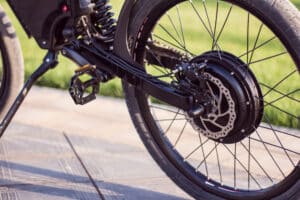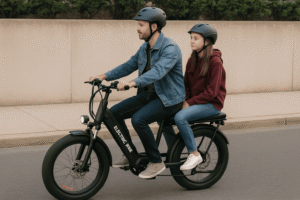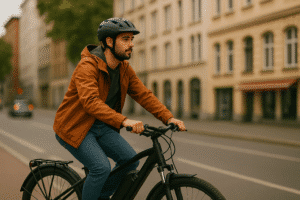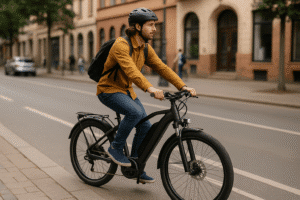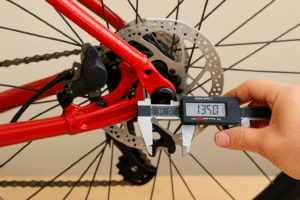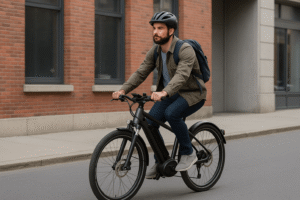If you’re in the delivery business, an electric bike can be a game-changer. It’s faster than a regular bike, cheaper than a car, and better for the environment. On average, e-bike riders save around $1,500 per year on fuel and transport costs compared to car owners.
In this guide, we’ll break down why e-bikes are great for delivery, the key features to look for, and important legal and safety tips—all in a simple and easy-to-follow way.
Why Choose an Electric Bike for Delivery?

So, why are e-bikes becoming the go-to for delivery folks? There are many benefits to consider, and here’s a breakdown of the key ones:
- Efficiency: Zip through traffic and make more deliveries in less time.
- Eco-Friendly: Lower your carbon footprint – good for you and the planet.
- Cost-Effective: Save on fuel and maintenance costs compared to a car or motorcycle.
- Health Benefits: Get a bit of exercise without overdoing it.
Factors to Consider Before Buying an e-Bike for Delivery
Knowing how to choose an electric bike for delivery goes beyond just picking the coolest-looking one. It’s about finding the bike that fits your delivery needs and your budget.
1. E-Bike Class and Legal Compliance
Understanding e-bike classes is crucial for making an informed choice. Here’s a breakdown:
- Class 1: These are pedal-assist-only e-bikes with no throttle. The motor assists you only when you’re pedaling and cuts off at 20 mph. They’re generally allowed on bike paths and are great for urban deliveries where speed and maneuverability are key.
- Class 2: Similar to Class 1 in terms of the speed limit, but these come with a throttle, allowing you to ride without pedaling. This can be handy for quick starts at traffic lights or when you need a break from pedaling.
- Class 3: These are also pedal-assist but can reach speeds up to 28 mph. They’re often equipped with a speedometer. Ideal for longer-distance deliveries, but be aware of local regulations as they might be restricted on certain bike paths.
When you’re learning how to choose an electric bike for delivery, it’s important to note that Class 1 or 3 e-bikes are generally the best choices, offering a balance of speed and accessibility.
2. Distance Capacity and Battery Life
The range of your e-bike is determined by its battery capacity. Key factors affecting this include:
- Battery Capacity: Measured in watt-hours (Wh), a higher Wh rating means more range.
- Terrain: Hilly routes drain the battery faster than flat ones.
- Rider’s Weight and Cargo: Heavier loads require more power.
- Riding Style: Consistent pedaling with moderate assist saves battery life.
For delivery, opt for a battery with a high Wh rating to ensure you can cover your entire route on a single charge.
3. Frame Size and Ergonomics
Choosing the right frame size is about more than just height:
- Frame Geometry: A comfortable riding position reduces fatigue. Consider the distance between the seat and the handlebars and the standover height.
- Adjustability: Look for adjustable components like seat height and handlebar angle for a custom fit.
- Test Ride: Always test ride to ensure the bike feels right. What looks good on paper might feel different in practice.
4. Battery Size, Type, and Placement
Batteries vary in size, type, and where they’re placed on the bike:
- Size and Capacity: Larger batteries offer more range but add weight.
- Type: Lithium-ion batteries are common, offering a good balance of weight, capacity, and longevity.
- Placement: Batteries can be mounted on the frame or integrated into it. Frame-mounted batteries are easier to remove but can affect balance, while integrated batteries offer a sleeker look and better weight distribution.
5. Motor Efficiency and Type
The motor is the heart of your e-bike:
- Wheel Motors (Hub Motors): Often found in budget-friendly models. They’re simple and effective but can make the bike feel unbalanced.
- Mid-Drive Motors: Located in the bike’s center, offering better balance and efficiency. They’re ideal for hilly terrain and provide a more natural riding feel.
For deliveries, mid-drive motors are generally preferred for their efficiency and balance, especially if you’re navigating varied terrain.
6. Weight Considerations
The weight of the e-bike affects handling:
- Lighter Bikes: Easier to maneuver, which is great for city deliveries.
- Heavier Bikes: Offer more stability and durability but can be cumbersome in tight spaces.
Consider the type of deliveries you’ll be doing and choose a bike that strikes the right balance.
7. Frame Design and Material
The frame impacts the bike’s overall feel and durability:
- Step-Through Frames: Allow for easy mounting and dismounting, which is convenient for frequent stops.
- High-Step Frames: Provide more stability and are often seen in sportier models.
- Materials: Aluminum is lightweight and affordable, steel is durable, and carbon fiber is lightweight but expensive.
8. Lighting and Safety Features
Safety features are vital, especially for night deliveries:
- Lighting: Front and rear lights are essential. LED lights are bright and energy-efficient.
- Reflective Elements: Increase visibility to other road users.
- Brakes: Look for reliable brakes, such as disc brakes, for effective stopping power.
9. Cost and Value for Money
E-bike prices vary widely:
- Budget-Friendly Options: Good for starters but might lack advanced features.
- Mid-Range Bikes: Offer a balance of features and durability.
- High-End Models: Come with top-of-the-line features but at a higher cost.
Consider the total cost of ownership, including maintenance and potential upgrades. For delivery purposes, a mid-range e-bike often offers the best balance of cost, features, and durability.
Selecting the Right E-Bike for Your Delivery Needs

When you’re in the market for the best e-bike for delivery, it’s a bit like finding the perfect pair of shoes – it needs to fit just right and feel good, even after a long day.
Think about what your typical delivery day looks like. Are you zipping through city streets or cruising over longer distances? This will guide you in choosing the right motor type and battery capacity.
Remember, comfort is key, so pay attention to the frame size and design. It’s not just about how far or fast you can go; it’s about how you feel at the end of the day.
And let’s not forget durability – this bike’s going to be your workhorse, so it needs to be tough enough to handle the daily grind.
A Day in the Life: Real-World e-Bike Delivery Experience
Ever wonder what it’s really like to do deliveries on an e-bike? Check out this YouTube video from “BikeDasher,” where a delivery rider takes us through a typical day.
Starting just before noon and wrapping up around 2 PM, this rider hustles through the city, completing orders on both Uber Eats and DoorDash. In just over two hours, they rake in about $60 – not too shabby, right?
The video is a great showcase of how an e-bike can be a game-changer in the delivery world, especially when you’re juggling multiple apps. It’s about being smart, efficient, and making the most of your time and energy.
Maintenance and Upkeep
Let’s talk about keeping your e-bike in tip-top shape. Regular maintenance isn’t just about prolonging its life; it’s about ensuring your safety too.
Keep those tires inflated to the right pressure, check your brakes regularly, and don’t ignore any strange noises or vibrations – they’re your bike’s way of telling you something’s up.
And batteries, they’re like the heart of your e-bike, so treat them well. Charge them properly and store them in a cool, dry place. A little TLC goes a long way in keeping your e-bike running smoothly.
Conclusion
So there you have it – a straightforward guide to finding and caring for your e-bike for delivery. It’s about choosing a bike that fits your delivery style and keeping it well-maintained.
Remember, an e-bike isn’t just a tool for your job; it’s your partner on the road. Treat it right, and it’ll help you make your deliveries efficiently and sustainably. Happy riding!
FAQs
Can I use any e-bike for food delivery?
Not all e-bikes are ideal for delivery. Look for one with a long battery life, good cargo capacity, and a durable frame to handle daily use.
How long does an e-bike battery last for delivery?
Battery life varies based on capacity, terrain, and assist level, but most e-bikes for delivery can last 30-70 miles per charge. Carrying a spare battery can help extend your shift.
Do I need insurance for an e-bike used for delivery?
While not required in most places, some cities or delivery platforms may have insurance requirements for commercial e-bike use. Check local regulations and consider liability coverage for protection.
How much can I earn doing deliveries with an e-bike?
Earnings vary by location and platform, but riders typically make $15-$25 per hour, depending on demand, tips, and efficiency. E-bikes help maximize deliveries per shift.
What’s the best way to secure my e-bike during deliveries?
Use a high-quality U-lock and GPS tracker to prevent theft. Some riders also bring their e-bike inside when dropping off orders to avoid leaving it unattended.
Michael Josh is a hands-on e-bike tester and reviewer at BoltBikers, known for putting every model through real-world rides before sharing his thoughts. With a sharp eye for performance, comfort, and build quality, he helps the team choose which bikes are worth featuring. Backed by years of experience in tech and gear reviews, Michael brings trusted, honest insights to help readers find the right e-bike for their needs.
